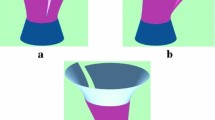Abstract
In this paper a general method is given for combining CSG modeling with soft blending using implicit surfaces. A class of various blending functions sharing some desirable properties like differentiability and intuitive blend control are given. The functions defining the CSG objects satisfy the Lipschitz condition that gives the possibility of fast root finding but can also prove useful in the field of collision detection and adaptive triangulation.
Similar content being viewed by others
References
Blinn J (1982) A generalization of algebraic surface drawing. ACM Trans Graph 1:234
Bloomenthal J (1988) Techniques for implicit modeling. Xerox PARC technical report P89-00106, November 1988
Bohm W et al (1984) A survey of curve and surface methods in CAGD. Comput Aided Geom Des 1(1):1–60
Hart J (1996) Sphere tracing: a geometric method for the antialiased ray tracing of implicit surfaces. Vis Comput 12(10):527–545 An earlier version appeared in the SIGGRAPH ’93 course notes as WSU Technical Report EECS-93-015
Pasko A, Adzhiev V, Sourin A, Savchenko V (1995) Function representation in geometricmodeling: concepts, implementation and applications. Vis Comput 11(8):429–446
Ricci A (1973) Constructive geometry for computer graphics. Comput J 16:157–160
Wyvill B (1990) A computer animation tutorial. Springer, Berlin Heidelberg New York
Wyvill B, McPheeters C (1986) Data structure for soft objects. Vis Comput 2(4):227–234
Author information
Authors and Affiliations
Corresponding author
Rights and permissions
About this article
Cite this article
Dekkers, D., van Overveld, K. & Golsteijn, R. Combining CSG modeling with soft blending using Lipschitz-based implicit surfaces. Vis Comput 20, 380–391 (2004). https://doi.org/10.1007/s00371-002-0198-3
Published:
Issue Date:
DOI: https://doi.org/10.1007/s00371-002-0198-3




